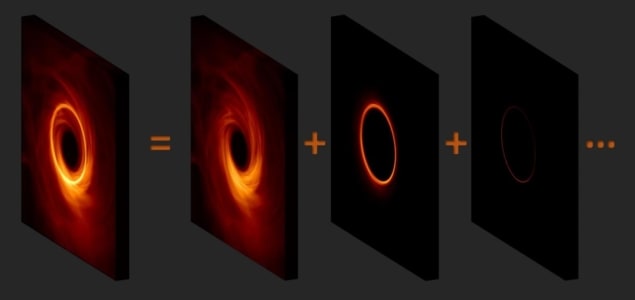
Adding a space telescope to the earthbound Event Horizon Telescope (EHT) should reveal the delicate series of light rings surrounding a supermassive black hole – according to a team of astrophysicists in the US. As well as providing more precise values for the mass and spin of a black hole, observing these “subrings” could also be a benchmark test of long-baseline interferometry using telescopes on Earth and in space.
In April 2019, scientists working on the EHT observed a glowing ring of light surrounding the supermassive black hole that lies at the heart of the M 87 galaxy. This first observation allowed the EHT team to determine the mass of the black hole to 6.5 billion solar masses, give or take 10%. EHT scientists we also able to work-out the direction of rotation (spin) of the black hole.
This light comes from hot matter swirling around the black hole. The light is deflected by the black hole’s immense gravitational field, making it appear like a ring to a distant observer. However, what the EHT was not able to discern is a series of subrings within this ring that should provide important information about the black hole.
A glimpse of complexity
“With the current EHT image, we’ve caught just a glimpse of the full complexity that should emerge in the image of any black hole,” says Michael Johnson of Harvard University, who was involved in this latest research.
Each of these subrings corresponds to a specific set of trajectories taken by the deflected light. Most of the light in the ring is the result of small deflections, which create a diffuse halo-like subring that is denoted n=0. Light can also follow a parabola-like path, doing a half-orbit of the black hole before escaping. This light is focussed into a thinner ring within the halo denoted n=1 because the light has made one half-orbit of the black hole.
Some light will complete one orbit of the black hole before escaping to create the even thinner n=2 subring. Indeed, a series of increasingly thinner rings are created by light that completes increasingly higher numbers of half-orbits of the black hole. As the number of half-orbits increases, the subrings also shrink in diameter and become less bright.
Very, very large arrays
Now, Johnson and colleagues have calculated the structure of these subrings and concluded that it should be possible to observe them using telescopes that are separated by very large distances.
The EHT is a network of radio telescopes that span a hemisphere of the Earth. Using a technique called very-long-baseline interferometry, the EHT is effectively an Earth-sized radio dish, which gives it extremely high angular resolution. In this latest work, the researchers have calculated that even this huge telescope is not good enough to discriminate between the first few subrings.
One way of spotting the n=1 subring, they say, could be to use a ground-based array of telescopes that are sensitive to lower-wavelength signals than the EHT. Another, possibility would be to launch radio telescopes into low-earth orbit. Detecting the n=2 ring would require a telescope on the Moon and seeing n=3 would require a telescope at the L2 Lagrangian point beyond the Moon.
The team says that one future option would be to use the Russian Millimetron mission which is expected to launch to L2 in 2029.
The research is described in Science Advances.



